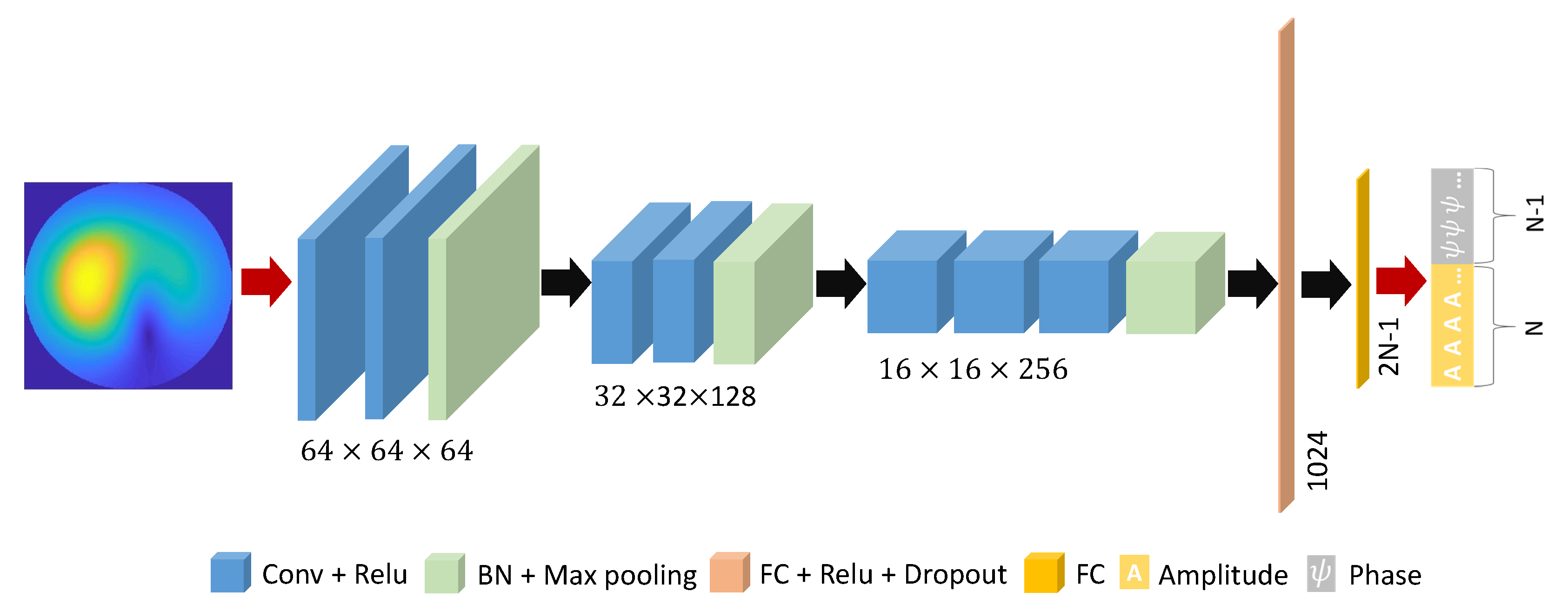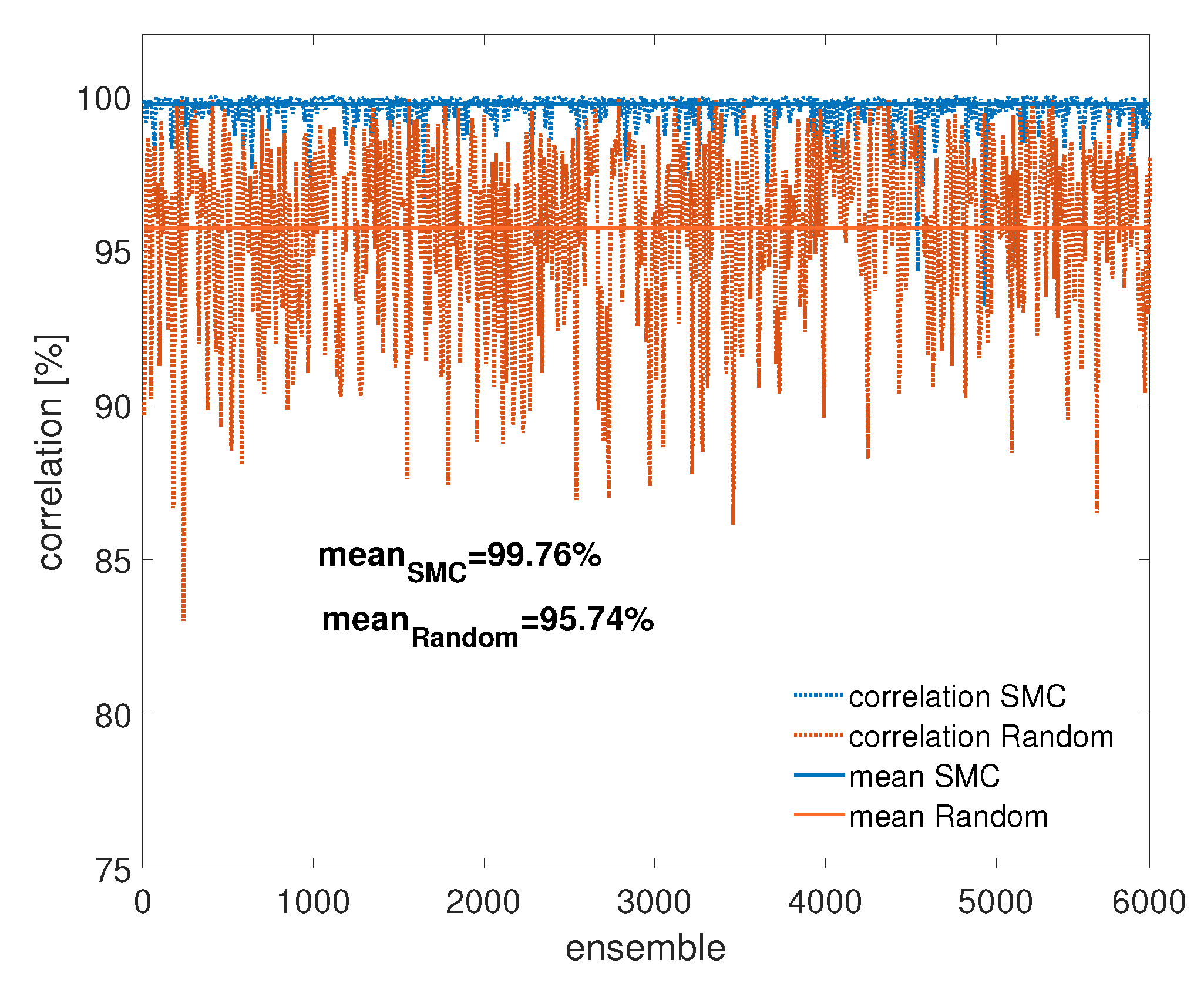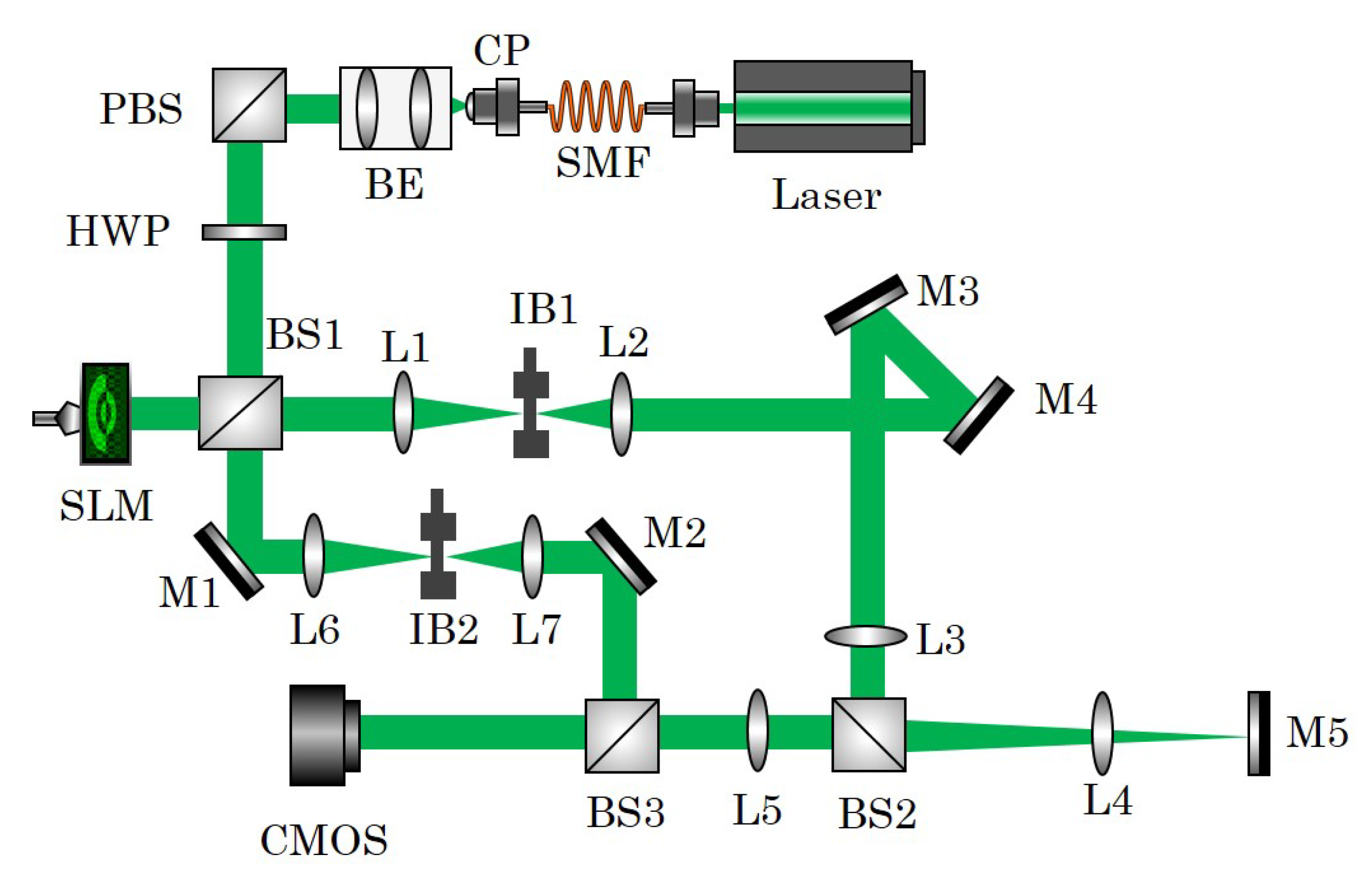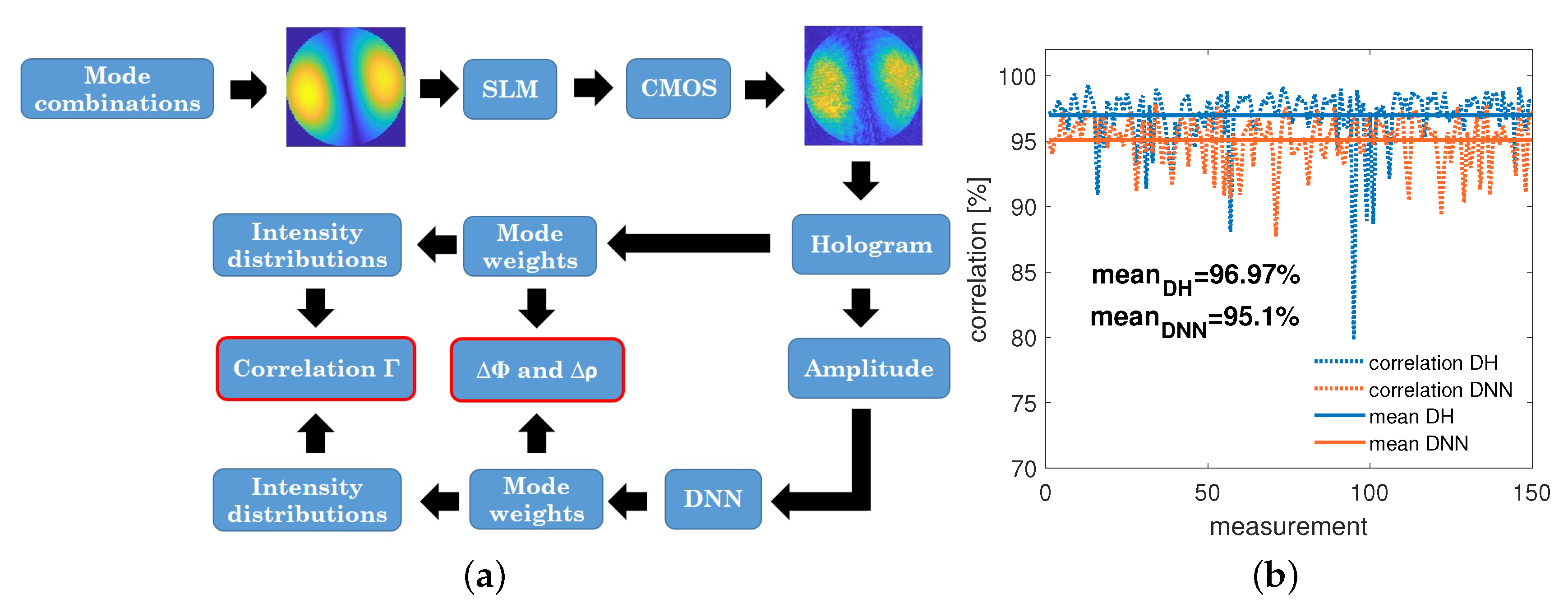Deep Learning for Computational Mode Decomposition in Optical Fibers
Abstract
1. Introduction
2. Methodology
2.1. Digital Holography-Based Modal Decomposition
2.2. Deep-Learning-Based Modal Decomposition
2.3. Specified Mode Combinations (SMC) Data Design for the Training Process
3. Results
3.1. Performance of the SMC Data Design
3.2. Performance of the DNN Using Experimental Data
4. Discussion
5. Conclusions
Author Contributions
Funding
Acknowledgments
Conflicts of Interest
References
- Čižmár, T.; Dholakia, K. Exploiting multimode waveguides for pure fibre-based imaging. Nat. Commun. 2012, 3, 1027. [Google Scholar] [CrossRef] [PubMed]
- Kuschmierz, R.; Scharf, E.; Koukourakis, N.; Czarske, J.W. Self-calibration of lensless holographic endoscope using programmable guide stars. Opt. Lett. 2018, 43, 2997–3000. [Google Scholar] [CrossRef] [PubMed]
- Ryf, R.; Randel, S.; Gnauck, A.H.; Bolle, C.; Sierra, A.; Mumtaz, S.; Esmaeelpour, M.; Burrows, E.C.; Essiambre, R.J.; Winzer, P.J.; et al. Mode-Division Multiplexing Over 96 km of Few-Mode Fiber Using Coherent 6×6 MIMO Processing. J. Light. Technol. 2011, 30, 521–531. [Google Scholar] [CrossRef]
- Garito, A.; Wang, J.; Gao, R. Effects of random perturbations in plastic optical fibers. Science 1998, 281, 962–967. [Google Scholar] [CrossRef] [PubMed]
- Gover, A.; Lee, C.; Yariv, A. Direct transmission of pictorial information in multimode optical fibers. JOSA 1976, 66, 306–311. [Google Scholar] [CrossRef]
- Vellekoop, I.M.; Mosk, A. Focusing coherent light through opaque strongly scattering media. Opt. Lett. 2007, 32, 2309–2311. [Google Scholar] [CrossRef]
- Mahalati, R.N.; Askarov, D.; Wilde, J.P.; Kahn, J.M. Adaptive control of input field to achieve desired output intensity profile in multimode fiber with random mode coupling. Opt. Express 2012, 20, 14321–14337. [Google Scholar] [CrossRef]
- Čižmár, T.; Dholakia, K. Shaping the light transmission through a multimode optical fibre: Complex transformation analysis and applications in biophotonics. Opt. Express 2011, 19, 18871–18884. [Google Scholar] [CrossRef]
- Cui, M.; Yang, C. Implementation of a digital optical phase conjugation system and its application to study the robustness of turbidity suppression by phase conjugation. Opt. Express 2010, 18, 3444–3455. [Google Scholar] [CrossRef]
- Papadopoulos, I.N.; Farahi, S.; Moser, C.; Psaltis, D. Focusing and scanning light through a multimode optical fiber using digital phase conjugation. Opt. Express 2012, 20, 10583–10590. [Google Scholar] [CrossRef]
- Czarske, J.W.; Haufe, D.; Koukourakis, N.; Büttner, L. Transmission of independent signals through a multimode fiber using digital optical phase conjugation. Opt. Express 2016, 24, 15128–15136. [Google Scholar] [CrossRef] [PubMed]
- Bianchi, S.; Di Leonardo, R. A multi-mode fiber probe for holographic micromanipulation and microscopy. Lab Chip 2012, 12, 635–639. [Google Scholar] [CrossRef] [PubMed]
- Plöschner, M.; Tyc, T.; Čižmár, T. Seeing through chaos in multimode fibres. Nat. Photonics 2015, 9, 529–535. [Google Scholar] [CrossRef]
- Carpenter, J.; Thomsen, B.C.; Wilkinson, T.D. Degenerate mode-group division multiplexing. J. Light. Technol. 2012, 30, 3946–3952. [Google Scholar] [CrossRef]
- Loterie, D.; Farahi, S.; Papadopoulos, I.; Goy, A.; Psaltis, D.; Moser, C. Digital confocal microscopy through a multimode fiber. Opt. Express 2015, 23, 23845–23858. [Google Scholar] [CrossRef] [PubMed]
- Caravaca-Aguirre, A.M.; Niv, E.; Conkey, D.B.; Piestun, R. Real-time resilient focusing through a bending multimode fiber. Opt. Express 2013, 21, 12881–12887. [Google Scholar] [CrossRef] [PubMed]
- Nicholson, J.; Yablon, A.D.; Ramachandran, S.; Ghalmi, S. Spatially and spectrally resolved imaging of modal content in large-mode-area fibers. Opt. Express 2008, 16, 7233–7243. [Google Scholar] [CrossRef]
- Rothe, S.; Koukourakis, N.; Radner, H.; Lonnstrom, A.; Jorswieck, E.; Czarske, J.W. Physical Layer Security in Multimode Fiber Optical Networks. Sci. Rep. 2020, 10, 2740. [Google Scholar] [CrossRef]
- Rothe, S.; Radner, H.; Koukourakis, N.; Czarske, J. Transmission Matrix Measurement of Multimode Optical Fibers by Mode-Selective Excitation Using One Spatial Light Modulator. Appl. Sci. 2019, 9, 195. [Google Scholar] [CrossRef]
- Mir, M.; Bhaduri, B.; Wang, R.; Zhu, R.; Popescu, G. Quantitative phase imaging. Prog. Opt. 2012, 57, 133–217. [Google Scholar]
- Loterie, D.; Farahi, S.; Psaltis, D.; Moser, C. Complex pattern projection through a multimode fiber. In Adaptive Optics and Wavefront Control for Biological Systems; International Society for Optics and Photonics: Bellingham, WA, USA, 2015; Volume 9335, p. 93350I. [Google Scholar]
- Bhaduri, B.; Edwards, C.; Pham, H.; Zhou, R.; Nguyen, T.H.; Goddard, L.L.; Popescu, G. Diffraction phase microscopy: Principles and applications in materials and life sciences. Adv. Opt. Photonics 2014, 6, 57–119. [Google Scholar] [CrossRef]
- An, Y.; Huang, L.; Li, J.; Leng, J.; Yang, L.; Zhou, P. Learning to decompose the modes in few-mode fibers with deep convolutional neural network. Opt. Express 2019, 27, 10127–10137. [Google Scholar] [CrossRef] [PubMed]
- Gloge, D. Weakly guiding fibers. Appl. Opt. 1971, 10, 2252–2258. [Google Scholar] [CrossRef] [PubMed]
- Koukourakis, N.; Abdelwahab, T.; Li, M.Y.; Höpfner, H.; Lai, Y.W.; Darakis, E.; Brenner, C.; Gerhardt, N.C.; Hofmann, M.R. Photorefractive two-wave mixing for image amplification in digital holography. Opt. Express 2011, 19, 22004–22023. [Google Scholar] [CrossRef]
- Barbastathis, G.; Ozcan, A.; Situ, G. On the use of deep learning for computational imaging. Optica 2019, 6, 921–943. [Google Scholar] [CrossRef]
- Borhani, N.; Kakkava, E.; Moser, C.; Psaltis, D. Learning to see through multimode fibers. Optica 2018, 5, 960–966. [Google Scholar] [CrossRef]
- Simonyan, K.; Zisserman, A. Very deep convolutional networks for large-scale image recognition. arXiv 2014, arXiv:1409.1556. [Google Scholar]
- Glorot, X.; Bordes, A.; Bengio, Y. Deep sparse rectifier neural networks. In Proceedings of the Fourteenth International Conference on Artificial Intelligence and Statistics, Fort Lauderdale, FL, USA, 11–13 April 2011; pp. 315–323. [Google Scholar]
- Ioffe, S.; Szegedy, C. Batch normalization: Accelerating deep network training by reducing internal covariate shift. arXiv 2015, arXiv:1502.03167. [Google Scholar]
- Brüning, R.; Gelszinnis, P.; Schulze, C.; Flamm, D.; Duparré, M. Comparative analysis of numerical methods for the mode analysis of laser beams. Appl. Opt. 2013, 52, 7769–7777. [Google Scholar] [CrossRef]
- Kingma, D.P.; Ba, J. Adam: A method for stochastic optimization. arXiv 2014, arXiv:1412.6980. [Google Scholar]
- García-Márquez, J.; López, V.; González-Vega, A.; Noé, E. Flicker minimization in an LCoS spatial light modulator. Opt. Express 2012, 20, 8431–8441. [Google Scholar] [CrossRef] [PubMed]





| SMC | ||||
| Random |
| DH | ||||
© 2020 by the authors. Licensee MDPI, Basel, Switzerland. This article is an open access article distributed under the terms and conditions of the Creative Commons Attribution (CC BY) license (http://creativecommons.org/licenses/by/4.0/).
Share and Cite
Rothe, S.; Zhang, Q.; Koukourakis, N.; Czarske, J.W. Deep Learning for Computational Mode Decomposition in Optical Fibers. Appl. Sci. 2020, 10, 1367. https://doi.org/10.3390/app10041367
Rothe S, Zhang Q, Koukourakis N, Czarske JW. Deep Learning for Computational Mode Decomposition in Optical Fibers. Applied Sciences. 2020; 10(4):1367. https://doi.org/10.3390/app10041367
Chicago/Turabian StyleRothe, Stefan, Qian Zhang, Nektarios Koukourakis, and Jürgen W. Czarske. 2020. "Deep Learning for Computational Mode Decomposition in Optical Fibers" Applied Sciences 10, no. 4: 1367. https://doi.org/10.3390/app10041367
APA StyleRothe, S., Zhang, Q., Koukourakis, N., & Czarske, J. W. (2020). Deep Learning for Computational Mode Decomposition in Optical Fibers. Applied Sciences, 10(4), 1367. https://doi.org/10.3390/app10041367








